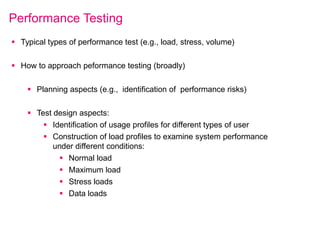iSQI Certification Days Advanced Level Technical Test Analyst Graham Bath
- 1. Technical Test analyst Overview of the ISTQB Advanced Level Certification
- 2. Technical Test Analyst: Principal Tasks Structure-Based Testing Analytical Techniques Quality Characteristics Security Testing Performance Testing Other Attributes Reviews with Checklists Test Tools and Automation 2 The Technical Test Analyst: Contents
- 3. Technical Test Analyst Tasks and Skills Similarities with TA: The Technical Test Analysts (TTA) supports an effective test process Focus on the analysis and design steps Often there is no fixed TTA role Different focus of TTA: For the TTA the focus is on technical aspects Risks associated with technical quality attributes Working closer to the architecture and code Becoming more relevant ! Required skills set expanding rapidly 3
- 4. Security Testing Test Tools and Automation Performance Testing 4 TTA as a Platform for Specialist Subjects Advanced Level Security Tester Advanced Level Test Automation Engineer Foundation Level Performance Tester
- 5. Structure-Based Testing Select the best technique(s) Write test cases for given coverage Decison Condition Testing Modified DC Testing (MC/DC) Multiple Condition Testing Path Testing API Testing Condition Testing
- 6. Analytical Techniques Static analysis Control flow analysis (e.g., dead code, endless loops) Data flow analysis (e.g., incorrect use of data in code) Call graphs (e.g., to help identify bottle-necks and determine integration sequences) Dynamic analysis Memory use (e.g., identification of leaks and incorrect usage of pointers) Tool support
- 7. Functional Suitability Usability Performance efficency Reliability Maintainability Portability Compatibility Security Quality Characteristics What are the various attributes? How to approach testing (broadly) Introduce subjects which are covered in specialist modules SPECIALIST SPECIALIST SPECIALIST TA TA TTA TTA TTA TTA TTA TTA
- 8. Security Testing Typical categories of security vulnerability (e.g., DOS, input buffer overrun) How to approach security testing (broadly) Planning aspects (e.g., identification of security risks and vulnerabilities) Test design aspects (e.g., design of security attacks)
- 9. Performance Testing Typical types of performance test (e.g., load, stress, volume) How to approach peformance testing (broadly) Planning aspects (e.g., identification of performance risks) Test design aspects: Identification of usage profiles for different types of user Construction of load profiles to examine system performance under different conditions: Normal load Maximum load Stress loads Data loads
- 10. Reliability Maintainability Portability Compatibility Other Quality Characteristics Recognizing the need to evaluate the different attributes and their sub-attributes How to approach testing (broadly) TTA TTA TTA TTA
- 11. Test Automation 11 • Tool selection and ownership issues • See specialist module Using Checklists in Technical Reviews • Checking architectural designs • Performing code reviews
- 12. 12 The exam This book may also help Questions Duration Duration (non-English) Pre-Condition: Foundation level certificate Getting Help www.istqb.org • Syllabi • Sample papers











